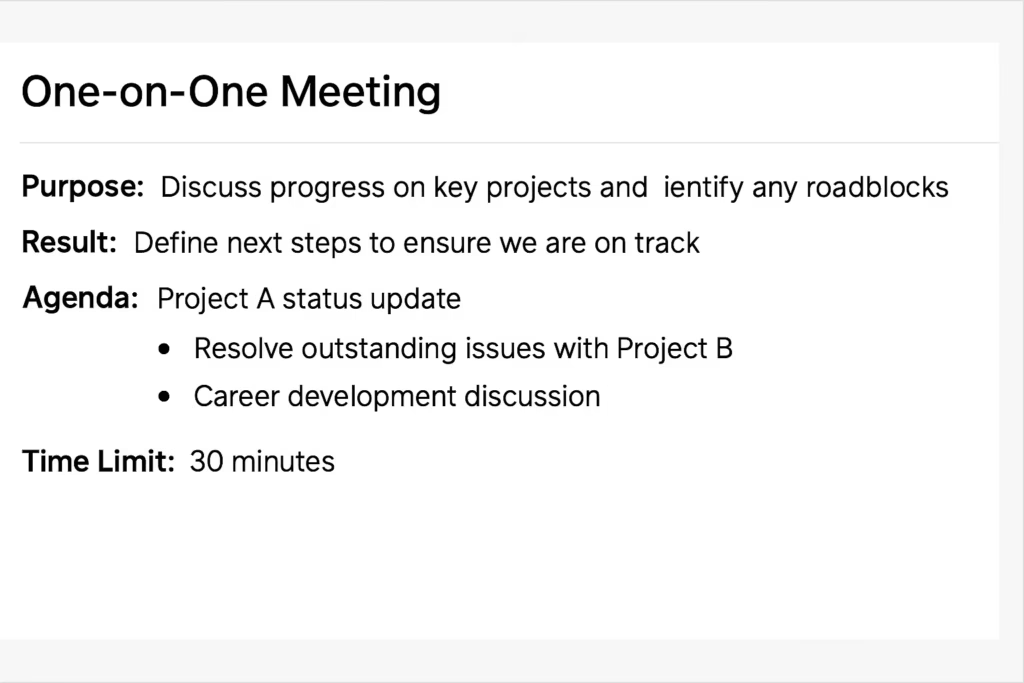Meetings with staff members are challenging to get right.
The art of hosting a productive meeting is one of the most important management skills you can master.
The art of hosting a productive one-to-one is one of the most important management skills you can master. This blog takes you through simple, practical ways to communicate with a team member and drive better results—using the lightweight PRAT Method.
Why hold one-to-one meetings?
One-to-one meetings can hold an important place in management.
There are many reasons why you will choose to have a meeting with your staff members, but they generally fall into 3 main categories:
- Performance Management – checking in on an employee’s performance, providing feedback, and coaching
- Professional Development – articulating your vision of where you see the employee progressing over time
- Support & Engagement – helping your employee solve a problem (without managing their monkey), or checking on their well-being
You Probably Know that Most Meetings Suck
Meetings Are Eating Our Time
According to Atlassian, the average professional attends 62 meetings a month, and about half of those are unproductive, amounting to 31 hours lost in pointless discussions every month.
Most Meetings Don’t Deliver
A study from AIHR found that 71% of all meetings are seen as unproductive, and 15% of total work hours are spent in meetings .
One-on-Ones Drive Engagement
Gallup reports that only 15% of employees without regular one-on-ones feel engaged at work, compared with 86% of companies with “highly engaged” teams that hold them routinely (vs. 50% among low-engagement firms).
So Many 1:1s Miss the Mark
In a survey of 250 direct reports, nearly half rated their one-on-one experiences as sub-optimal, highlighting how often these sessions fall short of their promise linkedin.com.
Meetings and How Top Companies Approach Them
Meetings are so important to get right and interestingly enough, companies have thought up unique ways to make their meetings time-efficient, and productive.
At Amazon, every meeting must obey the Two-Pizza Rule (no more attendees than two pizzas can feed) and typically opens with 20–30 minutes of silent memo reading—no slides allowed—so everyone arrives prepared for a sharp discussion.
Google, by contrast, insists each meeting have a single owner, a crystal-clear purpose, and a written agenda distributed at least 24 hours in advance to keep conversations focused and democratic.
Netflix treats meetings as opportunities for collective learning—starting and ending on time, with tightly crafted agendas designed to capitalise on its “dream team” of top performers.
How Should You Approach Meetings? –
One thing I dislike is when a meeting is impromptu and not well-organised.
When there is a proper agenda, a meeting has direction.
Both you and your employee should gain clarity, and not leave the meeting with no idea about what the meeting was about.
Jeff Bezos at Amazon knew the importance of every meeting being productive.
He insisted that anyone who called a meeting had a 1-page summary of the key points of the meeting as well as 6 pages project breakdown. I guarantee that if every company took a similar approach, there would be far fewer meetings.
The PRAT Method (A Simple Framework for Meetings)
A basic framework you can use to plan your meeting is as follows:
| Component | Description |
| Purpose | Define why you’re holding the meeting at all. Is a discussion necessary, or could this be an email? |
| Result | Specify the concrete outcome you need—e.g., a decision made, a plan agreed, or feedback gathered. |
| Agenda | List the key topics or questions you’ll cover to drive you toward that result. |
| Time Limit | Set a hard duration so you stay focused and respect everyone’s schedule. |
I call this unique framework the PRAT method. Although there are other points you might want to consider, depending on the complexity of the subject, at least consider the basic concepts in this framework.
The PRAT Method is a lightweight framework to ensure every meeting is purposeful, outcome-driven and efficient. It breaks planning into four simple components.
How to use PRAT:
- Before inviting anyone, fill out all four fields.
- In your invite, include the purpose and result in the description, and the agenda as bullet points.
- Stick to the Time Limit by starting on time, parking off-topic items, and closing with a quick recap of results and next steps.

This framework is very lightweight so here are some ways you can extend PRAT if your meeting requires more scope.
Where You Can Extend PRAT
- Participants & Roles
PRAT assumes you know who needs to be there, but explicitly naming decision-makers, consult-only attendees, or subject-matter experts can sharpen accountability. - Pre-Work & Materials
Adding a quick “Prep” section can make the live session more productive. - Follow-Up & Tracking
While “Result” and “Time Limit” get you through the meeting, a brief “Next Steps” or “Owner & Due Date” note (even just tacked onto the invite) ensures momentum carries forward.
For Your Next Meeting…
By focusing every meeting on a clear Purpose, defining the tangible Result you need, outlining an actionable Agenda, and respecting a strict Time Limit, you’ll transform routine check-ins into high-impact conversations.
Remember: good meetings aren’t just about talking—they’re about driving decisions, growth, and engagement.
I’d love to hear how you run your one-to-ones!
Drop a comment below with your own tips, or share a story about a meeting that went exceptionally well (or terribly wrong).


